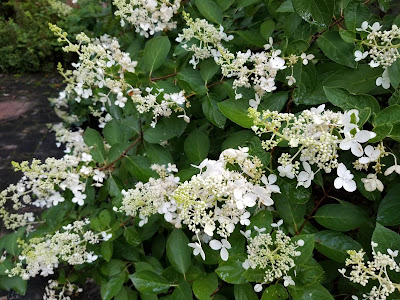So here we are at the end of 2020. It has been, and continues to be a crazy year. The garden has been a great escape from the world and brings us a lot of joy. This blog is best viewed on a computer monitor or TV and not a cell phone. A cell phone screen is too small and you really can't observe the depth of the plants, the variation in flower and leaf color or their texture. So, take your face out of the phone, get on the computer or fire up a browser on your TV and take it all in. This is the 2020 Tin Roof Gardens Hydrangea Edition. Hope you enjoy it.
Arborescens hydrangea Annabelle in white with an Invincibelle Spirit II in pink. Along the back against the fence in the upper right you can see the Oakleaf in bloom as well.
Different angle of the same bed above but this time with the Oakleaf Harmony or Loaf of Bread Oakleaf. Its just a stunner with its massive flowers. They are smooth as silk to the touch.
They are prolific bloomers when happy.
A close-up with a daddy longlegs spider in the center.
Another view to show the size and color variation. They get quite heavy when it rains so you will have to stake some limbs.
It bloomed very well this year. Probably the best its ever looked. A very attractive lacecap variety.
A row of classic hydrangea quercifolia Oakleaf and Oakleaf Alice to the left. Alice is a larger, taller plant with stockier blooms.
This is classic hydrangea quercifolia Oakleaf. Always a winner.
A perfect classic quercifolia Oakleaf bloom. Mature plants can produce 14 inch or 35.56 cm flowers. Some are dense like the one to the left and others like the image below are more open.
Although it doesn't look that large in the image, this is a colossal Oakleaf Alice bloom. The largest, fattest bloom we have ever had.
As the blooms fade, the color change is seasonally variable. Sometimes we get very little color and they just fade to brown. This year we had nice pink shades.
These are small Alice blooms.
This is drawf quercifolia Oakleaf PeeWee. I've found that it takes a few seasons to get established before its starts to flourish.
The blooms are quite short and the plant only grows about 3 feet or 91 cm tall.
While we are on the dwarfs, this is hydrangea paniculata Little Quick Fire. We haven't had good pink fall color yet but it does bloom well as long as it gets plenty of sun.
Continuing with dwarf sun lovers, this is Bobo paniculata. This plant gets scorched in the afternoon sun and just blooms beautifully in mid to late July. Its compact so great for pots or containers too.
This Bobo paniculata is in a location that get periodic sun. Some morning, mid-day and a little afternoon. It still blooms well but not as good as the one above that gets more sun.
This was a new addition last season and bloomed quite nicely this year. Its a hydrangea macrophylla Zebra. White mopheads with serrated edges and black stems make for quite a contrast. It should be glorious next season.
Hydrangea paniculata Silver Dollar is a favorite. A relatively short paniculata with strong stems and large blooms. It was developed by the Royal Horticultural society in the UK. If you look behind it, that is paniculata Chantilly Lace starting to emerge.
Another image of Silver Dollar as it comes into bloom.
Hydrangea paniculata Little Lamb is always a showstopper. A prolific bloomer when happy, it never disappoints.
A close-up of the chunky paniculata Little Lamb blooms.Hydrangea macrophylla Blue Wave finally bloomed after several years of growth. We had quite a color variation on the same plant.
Nothing quite blue this year but perhaps next season.
Hydrangea paniculata Chantilly Lace is the latest blooming hydrangea in the garden. It blooms in late July and continues though August. Its a sun lover so do not plant it in a shady location. This is actually three plants wrapped around a split trunk beech tree.
Another view of Chantilly Lace. The flowers are very open and frilly so they don't sag when it rains.
A close-up of a Chantilly Lace bloom starting to emerge.
I don't know why hydrangea paniculata White Moth is not well known. Just look at this plant in peak bloom. Its striking. Its also visited by pollinators more so than any other hydrangea in the garden.
A close-up of the dainty White Moth bloom. If you have room in a sunny location, you should plant this one.
Last but not least, hydrangea macrophylla Nikko Blue.
This is Nikko Blue in pink.
And Nikko Blue in a flourish of blue, pink and purple.
Nikko Blue in front of a bed of Gooseneck loosestrife (Lysimachia clethroides).
An finally, we have our glorious Schizophragma hydrangeoides Moonlight with a lavender Angel Clematis growing up through it. Sadly the Oak it was going on died and had to be removed. We replanted portions of the Schizo base root in two locations but it takes years to recover and grow to this height. Maybe in 10 years I'll have another image to show.
.































































